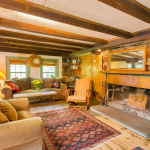These days, the vast majority of consumers venture online to begin their search for properties to buy or rent. Some statistics show the number is upwards of ninety-two percent.
When using the Internet to market your historic property regardless of whether you use an agent or not you have seconds to connect with prospective buyers online. This is where your property has the opportunity to introduce itself to the marketplace. Making the right first impression is of the utmost importance since that might be your only shot. The goal is to sell your house and sell it quickly. Just like web sites, it is important that once potential buyers click on your property that they don’t bounce off that page for a reason that could have been easily avoided if some useful strategies were set in place before making the listing debut. Real estate sales and marketing is a very visual experience just like travel. Sellers need to collaborate with their brokerage and agent to develop a strong visual story about their property that will immediately engage potential buyers and buyer’s agents.
What can a seller and agent do to ensure that their property stands out from the rest and sells quickly? Here are our top 10 tips on making sure your listing is effective, engaging and sells your historic property as quickly as possible.
1. One Word: Photography—Historic properties are by definition works of art and nothing brings an historic property to life online better than great photography. If your marketing budget allows, hire a professional photographer. If you’re taking property photographs yourself: declutter the rooms, light the fireplaces, clean up the yard, turn on the interior lights, wait for good weather and great light (early morning or late afternoon) and open the blinds to let the light in. Try to get an exterior twilight photograph with all of the interior lights on when the sky is still light blue. Don’t post photographs of the scary rubblestone basement.
2. Second Word: Photography—Yes we’re going to say it again but this time we’re talking specifically about your money shot. This is the first photograph that you lead with in your film strip and the photograph that shows up on every search page. You really do only have a few seconds to make a first impression. And this is the first photo that every visitor will see. So choose it wisely as if it’s the only photograph you’re allowed to list. Double check how it shows up on the front end since some automatic cropping may occur and alter your photos. Aerial photography either via plane, helicopter or drones is something to consider when your real estate offers extensive property grounds and acreage.
 3. Tell A Visual Story—Load and organize your photographs to tell a story and create a virtual visual walk-through. Include a well-lit photo of each room, hallways, bathrooms, exterior elevations, landscaping, out buildings, and a curb appeal money shot at the right time of day. Don’t overlook the little things if your property has unique architectural features, lighting, woodwork, or historical details.
3. Tell A Visual Story—Load and organize your photographs to tell a story and create a virtual visual walk-through. Include a well-lit photo of each room, hallways, bathrooms, exterior elevations, landscaping, out buildings, and a curb appeal money shot at the right time of day. Don’t overlook the little things if your property has unique architectural features, lighting, woodwork, or historical details.
4. Think Like A Photo Editor—Add captions to each photograph that at minimum identify to the viewer where a photo was taken and of what room and/or exterior elevation view. Many people search online the way they read a magazine article: they will spend more time looking at your property photos than they will reading your detailed property description so captions that restate key features, amenities, and property details are even better.
 5. Think Like A Merchandiser—Everyone knows that stores are staged in a way that stimulate a visual and psychological response so that a prospective consumer buys a product. The same theory should be applied to marketing real estate. Stage your home either by using a professional stager/organizer or just commit some sweat equity into making your home look its best by removing oversized furniture that makes rooms look small, remove items that are too personal like refrigerator “art” and put children’s toys away. Remember prospective buyers need to visualize their new life in your home and not see yours.
5. Think Like A Merchandiser—Everyone knows that stores are staged in a way that stimulate a visual and psychological response so that a prospective consumer buys a product. The same theory should be applied to marketing real estate. Stage your home either by using a professional stager/organizer or just commit some sweat equity into making your home look its best by removing oversized furniture that makes rooms look small, remove items that are too personal like refrigerator “art” and put children’s toys away. Remember prospective buyers need to visualize their new life in your home and not see yours.
6. Give Them What They Want—Most people do most of their real estate, travel, and design search online because it’s the quickest way to get the most amount of information in one place. So don’t sell the consumer short. Be as detailed as you can in listing all of the specific information available for you property. You may think the fact that your property is Victorian is not important but it might make all the difference for a prospective renter or buyer.
7. Features And Amenities—Front steps, windows, and a roof are  necessities not amenities. So stick to bullet points that capture what makes your property unique. A fenced yard, pool, finished basement, new appliances or HVAC, perennial landscaping, and granite countertops come to mind. Cultural amenities such as a weekly farmers’ market, restaurants, parks close by, galleries, shopping or a local theater are also conveniences that buyers look for so make them be known.
necessities not amenities. So stick to bullet points that capture what makes your property unique. A fenced yard, pool, finished basement, new appliances or HVAC, perennial landscaping, and granite countertops come to mind. Cultural amenities such as a weekly farmers’ market, restaurants, parks close by, galleries, shopping or a local theater are also conveniences that buyers look for so make them be known.
8. Property Description—The hardest thing to write is a  well-balanced property description. If it’s too long, people just ignore it and read your photo captions (see #3 above). Too short and they never get interested. A good rule of thumb is to keep it to no more than 250 words or around three paragraphs of a 4-5 sentences each. Think like a newspaper journalist first. Keep sentences short and descriptive. Don’t waste words. Get the important points in first up front. If your property location offers a specific lifestyle (waterfront, mountains, desert or a historic walkable town or urban city center) highlight it.
well-balanced property description. If it’s too long, people just ignore it and read your photo captions (see #3 above). Too short and they never get interested. A good rule of thumb is to keep it to no more than 250 words or around three paragraphs of a 4-5 sentences each. Think like a newspaper journalist first. Keep sentences short and descriptive. Don’t waste words. Get the important points in first up front. If your property location offers a specific lifestyle (waterfront, mountains, desert or a historic walkable town or urban city center) highlight it.
 9. Architectural History—Thanks to their uniqueness, all historic properties in one way or another confer bragging rights and our visitors and prospective buyers love the finer details. If you have any information on your property’s architectural history, previous owners, or the place it served in history, prospective buyers wants to know about it. If a local preservation or architectural organization has more information about your property online include their links.
9. Architectural History—Thanks to their uniqueness, all historic properties in one way or another confer bragging rights and our visitors and prospective buyers love the finer details. If you have any information on your property’s architectural history, previous owners, or the place it served in history, prospective buyers wants to know about it. If a local preservation or architectural organization has more information about your property online include their links.
 10. Back To Grade School—Write, read, review, repeat. Like it or not there are historic buyers and consumers who write off attractive properties due to bad grammar and sloppy photography. Take an extra five minutes to proof-read your listing for spelling errors and double-check your photos to make sure they are the right resolution. Your property listing is a reflection of you so lead with your best presentation.
10. Back To Grade School—Write, read, review, repeat. Like it or not there are historic buyers and consumers who write off attractive properties due to bad grammar and sloppy photography. Take an extra five minutes to proof-read your listing for spelling errors and double-check your photos to make sure they are the right resolution. Your property listing is a reflection of you so lead with your best presentation.
